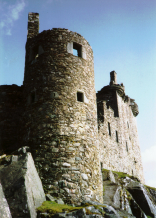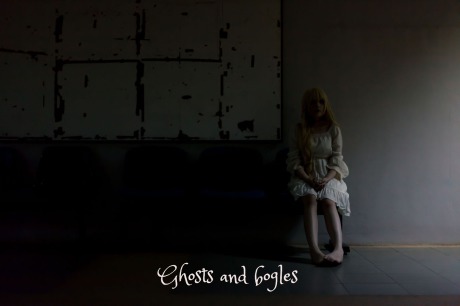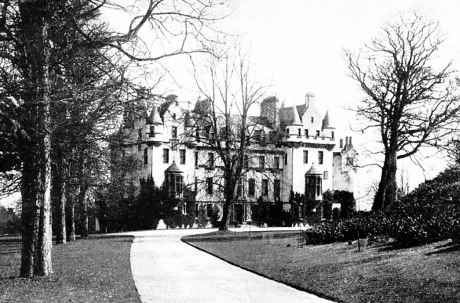The Ghostly Drummer of Cortachy Castle
Many noble families in Scotland have their own heralds of death: the appearance of a ghost or sometimes another kind of event which predicts a death.
These are akin to the Irish banshee (banshee means ‘fairy woman’ in Gaelic), which would be heard shrieking when a member of family was close to death or disaster was to come.
In Scotland many castles and great houses had spirits called gruagach, commonly now known as Green Ladies, who would be seen weeping if misfortune was to strike, but would also laugh to presage good tidings.
Other portentous events recorded are the appearance of an animal: a white stag among the Hamilton Earls of Arran, a ram (known as the ‘Doom of Airlie Castle’) for the Ogilvy Earls of Airlie (also see below), a robin for the inhabitants of Pitcaple Castle, a swan with a red breast for Kirkpatricks of Closeburn, and the howling of a hound at Barnbougle Castle.
In several places a bell is reputed to toll by itself. One story concerns the MacCullochs of Myrton. A ship transporting the bell and pulpit of Kirkmaiden Church across Luce Bay foundered and sank. Afterwards, a bell could be heard from the depths of the sea when one of the family was to perish; similar tales about the toll of a bell concern Abergeldie Castle, Coull and Craigdarroch House.
One of the creepiest stories, however, regards Cortachy Castle and its ghostly drummer.
Located about four miles north of the town of Kirriemuir in Angus, Cortachy Castle is an impressive and imposing country house, which incorporates an ancient castle within the present walls.
Cortachy has long been the property of the Ogilvy Earls of Airlie, and the building dates from the fifteenth century. The castle was sacked by the Earl of Argyll in 1641, was visited by Charles II six years later, but was then torched by Oliver Cromwell’s forces soon afterwards.
Following their involvement in the Jacobite Risings, the Ogilvys were forfeited and their titles stripped, and they did not recover the Earldom of Airlie until 1796, fifty years after culmination of the crushing of the Rising at the Battle of Culloden. The Earls still own Cortachy.
The events go back more than one hundred and fifty years. A guest staying at Cortachy Castle early in the spring of 1845 was Miss Margaret Dalrymple, who was accompanied by her companion, Mrs Ann Day, on a two-day visit.
They arrived late in the evening and Miss Dalrymple was given her room in the ancient part of the house and then had to hurry to dress in time for dinner.
Her host was the then Earl, David Ogilvy, who at that time, was married to his second wife, Margaret Bruce of Cowden – his first wife had died ten years earlier. The Earl was not in especially good health during the visit.
As she sat resting on a sofa in her chamber before dinner, Miss Dalrymple heard – as if directly beneath the floor – the sound of bagpipes and then, following that, the distinct beating of a drum.
Going down to dinner, and not suspecting anything might be amiss, she remarked to the Earl,
‘What is that strange music you have about the house? You assuredly have an excellent piper…’
The Earl dropped his cutlery and retired from the table, and did not reappear, going to library and eating there. Other diners were confused.
The following day, Mrs Ann Day was alone in Miss Dalrymple’s chamber. She later recounted:
‘The next morning, whilst the family were at breakfast, I was quite alone in Miss Dalrymple’s room, and as I stood up from the fire I heard, as I thought, a carriage drive up, and stop dead, directly under my feet. Immediately there followed the sound of another carriage drawing up, and stopping in exactly the same manner. And then, as if following the vehicles, came the tramp, tramp, tramp of marching soldiers. Then I heard some shrill notes of the instrument so distinctly that I looked round instinctively, expecting to see the piper in the room. In another moment I was more startled by the beating of a drum. About this there was something indescribably weird and disagreeable; it seemed as the drummer was making his way through the floor.
‘Being a perfect stranger to the place, I thought there might be a coach-road and an entrance-door to the castle, near the room in which I stood, and that some distinguished guests were arriving or departing.
‘On looking out of the window, however, I found there was no door nor coach-road near, and not a human being was to be seen. I concluded, therefore, that the sounds must have been echoed from a distance.
‘The next morning, before our departure, Lady Airlie came to the door of Miss Dalrymple’s room, to give her a £5 note for an orphan school in which she was interested. Neither of us ever saw the Countess again. She was confined of twins at Brighton some months afterwards and died. It was not until Miss Dalrymple, a few days after we left the castle, asked me if I had heard ‘the strange music there,’ that I disclosed my experience; and then for the first time I learned from her the tradition about the Airlie drummer-boy. She told me that she herself had been totally in ignorance of it, until her allusion at the dinner-table of the music she had heard elicited from another guest an explanation.’
The reason, of course, that the Earl was so disturbed by Miss Dalrymple’s announcement of piping and drumming was that this was not the first time it had been heard. Indeed, some years earlier, in 1835, the Earl himself had been staying with friends in England. While sitting in the garden, he had heard what he thought was a marching band, and had said so to the lady of the house. She reported hearing no such music, although he could still do so, including the thump of a drum.
The Earl realised that, according to family tradition, this might be the music that heralded a death in his family. The following day he learned of the death of his then wife, Clementina Graham of Duntrune, who had died unexpectedly because of a premature birth.
At the time of Miss Dalrymple’s visit, the Earl suspected that the phantom music might presage his own death but indeed he lived for a further four years.
The Countess of Airlie, Margaret Bruce, died in June of 1845 at Brighton during childbirth (she had twins, one of whom also died), which was some months after the manifestation of the phantom drummer. The Countess apparently believed the drummer had come for her, according to one author, writing:
‘I have heard that a paper was found in her desk after her death, declaring her conviction that the drum was for her; and it has been suggested that probably the thing preyed upon her mind and caused the catastrophe; but in the first place, from the mode of her death, that does not appear to be the case; in the second, even if it were, the fact of the verification of the prognostic remains unaffected; beside which, those who insist upon taking refuge in the hypothesis are bound to admit, that before people living in the world, like Lord and Lady Airlie, could attach so much importance to the prognostic as to entail such fatal effects, they must have had very good reason for believing in it.’
Nor was that the last time the drummer was heard. On the evening of 19th August 1849, a young Englishman was on his way to Tulchan of Glenisla, a plain shooting lodge in the remote, rugged but picturesque Glen Isla. Tulchan was also a property of the Earls of Airlie, and is located some twenty miles north and west of Kirriemuir, also in Angus.
The name of the young Englishmen is not recorded, unfortunately, but he was riding along with a local men to the lodge, having already covered a score of miles or so. At around half past eight, they had spied the house and were glad that their journey was almost over.
The Englishman, however, heard music, what he thought was a brass band, coming from a low ridge of ground in front of him. The music rather came and went on the wind, having an unearthly and eerie character, and the young man was surprised that a band might be found in such a remote location as there were no other houses near Tulchan.
Realising that his companion could not hear the sounds, the young man quizzed the local man, but his only response was that the music was ‘no canny’, spurring his mount onwards.
The young Englishman finally arrived at the lodge to find that his host, the future Earl of Airlie, had been called away to London because of the illness of his father. And that there were no musicians, either at the building or in the vicinity. He told other guests about hearing the eerie music, having no knowledge of the legend, and was told,
‘I fear the sound you have heard bodes no good, for there is an ancient legend that when the Head of the House of Airlie is about to die a band plays outside his house in Scotland.’
The next day, the 20th of August, the then Earl of Airlie died in Regent Langham Place in London.
So what is the legend of the drummer of Cortachy?
There are at least three versions of the tale behind the haunting. One is that in life the drummer failed to warn the Ogilvys when their castle was about to be attacked. Another tells that the man was romantically entangled, or so the Earl thought anyway, with the Earl’s wife.
Either way, the poor man was forced into his own drum and then cast off the battlements from the old part of the building (in which Miss Margaret Dalrymple was lodging when she heard the music). Just before he died, he cursed the family, warning them he would be heard playing as a herald of bad news.
A third version is that he was burnt to death here in 1645 after being taken as a hostage.
The drummer is also said to have been heard at Achnacarry, and even abroad in South Africa.
The next Earl, another David Ogilvie, died in 1881 in New Mexico in the USA. This time, two of his relatives heard drumming, although at Achnacarry, near Spean Bridge in the Highlands of Scotland (and nowhere near Cortachy), on the 25th of September 1881.
An account was written down by Lady Margaret Cameron of Locheil, whose family owned (and owns) Achnacarry.
‘After dinner I left the drawing room to get out a piece of china to show my sister-in-law, then Lady Dalkeith; and to the Countess of Lathom, then Lady Skelmersdale. On returning to the room both became silent; I noticed the fact but made no remark. Two days after, on Tuesday I think, on the arrival of the post, my sister-in-law, Lady Dalkeith, came to my room with newspaper in her hand and asked me first if there was any tradition about curious noises or sounds being heard in the family? On my answering her there was not, she asked if I had noticed Lady Skelmersdale’s and her silence on my return to the drawing-room two nights before? I replied in the affirmative. Then she told me that, while I was out of the room, she and Lady Skelmersdale distinctly heard the sound of a drummer beating the drum outside the house and remarked how it sounded like what they had heard described as ‘The Airlie Drummer’; but decided not to mention the subject for fear of alarming me in case there should be any tradition in the Locheil family. She then told me the death of Lord Airlie was announced in the paper as having taken place in America, the same night that she and Lady Skelmersdale had heard the sound.’
The Earl died of a fever and double pneumonia on the 25th. One explanation why the drummer might have been heard at Achnacarry is that he had been from the Cameron clan.
The drumming also apparently presaged the death of the then Countess of Airlie in 1884, and then the death of the next Earl (yet another David) in 1900, during fighting in the Boer War in South Africa. The Earl was a colonel in the Twelfth Lancers but was shot through the heart on the 11th of June at Diamond Hill in the Transvaal. The previous day was a Sunday, and Boer prisoners had complained about a band playing on the Sabbath, while other troops reported hearing a drum thumping away.
There are no tales that the ghostly drummer of Cortachy has been heard since. It should also be said that the stories surrounding the Airlie family were well known and featured in many newspapers, not least the Daily Telegraph, with long and detailed articles.
© Martin Coventry 2017
text from Scotland's Ghastly Ghosts
More info on Cortachy Castle from thecastlesofscotland.co.uk











